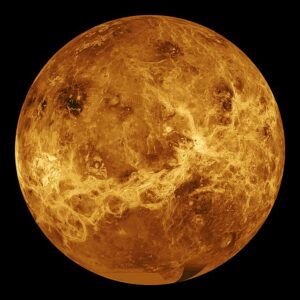Sept 25, 2023 | by Daniel Giamario |
Most of the action is in the morning sky. Let’s check in!
VENUS
 Now at her greatest brilliancy of magnitude -4.75, Venus dominates the morning sky, rising almost two hours before sunrise. On Monday morning, Venus is at 19Leo51. She is a good 43degrees ahead of the Sun on the way to greatest elongation on October 23. Venus is now travelling in a quite dim area of the stars in the zone between the Crab and Lion constellations. She will align with Regulus, just after the Moon joins her for the 6th chakra portal opening on October 10 at 1Virgo21. In all, Venus will have spent an astonishing 125 days in Leo, her new overstory. She will not reach Leo again until just after her rise out of the external underworld on July 11, 2024.
Now at her greatest brilliancy of magnitude -4.75, Venus dominates the morning sky, rising almost two hours before sunrise. On Monday morning, Venus is at 19Leo51. She is a good 43degrees ahead of the Sun on the way to greatest elongation on October 23. Venus is now travelling in a quite dim area of the stars in the zone between the Crab and Lion constellations. She will align with Regulus, just after the Moon joins her for the 6th chakra portal opening on October 10 at 1Virgo21. In all, Venus will have spent an astonishing 125 days in Leo, her new overstory. She will not reach Leo again until just after her rise out of the external underworld on July 11, 2024.
MERCURY
Well visible now in the best morning star apparition of the year for those in the Northern Hemisphere, Mercury is nearly 18degrees ahead of the Sun at 14Virgo57, and at a maximum morning elongation in the current Virgo overstory of 109 days that began on September 15. Mercury will end up being in Virgo for about 78 days before entering Libra on October 4. Now travelling through the stars of the Lion constellation, recently having passed Zosma and on meeting Denebola, the tail of the Lion, on September 29. In the Virgo synodic overstory, this is the Apollo phase, the time of straightforward, left-brain clear analytical thinking.
MARS
At a really dim +1.7 magnitude at 18Libra54, Mars is difficult to see, being only 17degrees from the Sun. Did any of you see the final Moon-Mars conjunction on September 18? I did not. Mars will be completely lost in the glare of the Sun as he descends into the underworld on September 30, accompanied by Spica and Heze of the Priestess constellation. See my recent article on this for more details, and also our “Journey of Inanna Revisioned” group now forming which joins together the understanding of the currently unfolding Venus and Mars cycles:
JUPITER
Visible at the end of morning dawn, Jupiter is quite brilliant at magnitude -2.8 and 138degrees ahead of the Sun. Located at 14Taurus50Rx, Jupiter remains in a 5degree square to Venus and is within 8 degrees of Uranus. In observing the morning sky, when seeing both Venus and Jupiter at the same time, you can get a good sense of what a square relationship looks and feels like. Jupiter is found in the stars of the Ram constellation.
SATURN
Soon to be the only evening star planet, Saturn glows at magnitude 0.55 in a rather dim area of the night sky in the stars of the Water Bearer constellation, and about two fists above the royal star Fomalhaut. Now in a quincunx relationship with the Sun (149degrees), Saturn rises shortly after sunset.
COMET NISHIMURA
I have heard that it may still be visible. Have any of you seen it? It is among the stars of the Priestess constellation.
